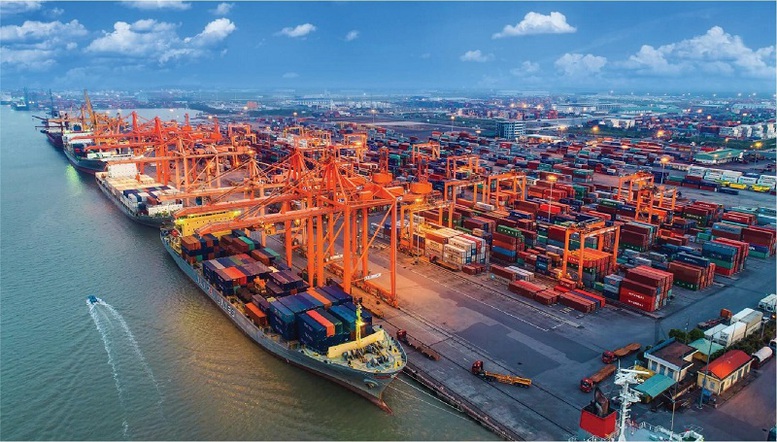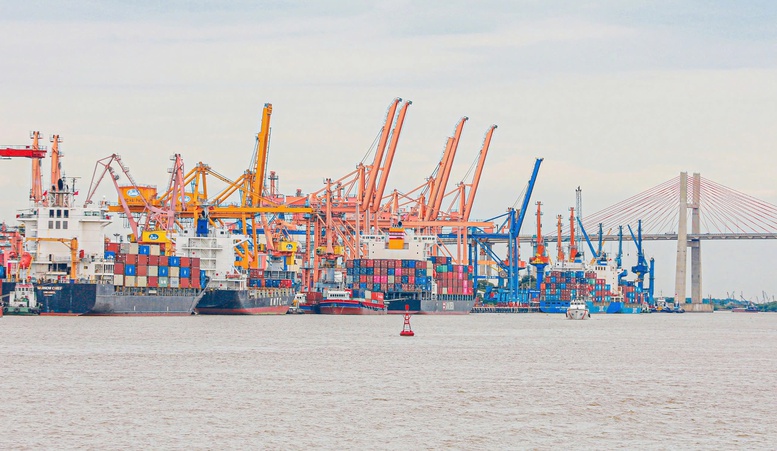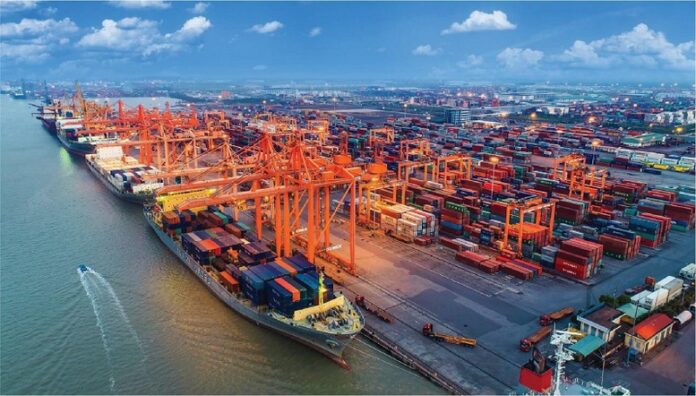The Ministry of Construction has recently approved the detailed planning for the development of Hai Phong seaport’s land and water areas for the period of 2021-2030, with a vision towards 2050.

A glimpse of Wharf No. 1 and No. 2 in Lach Huyen, Hai Phong
According to the approved plan, Hai Phong seaport comprises the following wharves: Lach Huyen, Dinh Vu, Song Cam-Pha Rung, Nam Do Son and Van Uc; Ben Cang Bach Long Vi Island; floating piers, transshipment areas, and anchorage areas for sheltering from storms.
Hai Phong Port to Handle up to 215 Million Tons of Cargo by 2030
By 2030, the port aims to facilitate the throughput of 175.4 – 215.5 million tons of cargo (including 12.15 – 14.92 million Teu of containerized cargo, excluding international transshipment) and serve 20,400 – 22,800 passenger embarkations.
The area will consist of 61 – 73 wharves, encompassing 98 – 111 berths with a total length ranging from 20,196 to 23,446 meters (excluding other wharves).
Envisioned by 2050, the port targets a cargo growth rate of 5 – 5.3% annually and a passenger growth rate of 1.5 – 1.6% per year.
During this phase, the development of new wharves will cater to the increasing cargo demand. This includes completing investments in the Lach Huyen wharf and relocating wharves on the Cam River in alignment with Hai Phong city’s development plan. Simultaneously, investments will be directed towards establishing wharves at Nam Do Son and Van Uc.
The total land requirement as per the plan until 2030 is approximately 1,638 hectares (excluding areas designated for industrial parks, logistics, and other port-related developments).
The total water area requirement as per the plan by 2030 is about 116,536 hectares (including water areas designated for other purposes within the managed zone, excluding maritime infrastructure).
The estimated investment capital needed for the port system by 2030 is VND 78,028 billion, including VND 11,950 billion for public maritime infrastructure and VND 66,078 billion for wharf investments (only covering wharves engaged in cargo handling services).
Lach Huyen Wharf to Accommodate Vessels up to 200,000 Tons
As per the planning, by 2030, the Lach Huyen wharf will handle 61.4 – 90 million tons of cargo and serve 10,500 – 11,000 passenger embarkations.
The wharf will encompass 14 – 16 wharves, consisting of 15 – 18 berths with a total length ranging from 5,625 to 6,875 meters (excluding other wharves). Among these, Wharves No. 1, 2, 3, and 4 will receive vessels with a capacity of up to 165,000 tons (12,000 Teu). Wharves from No. 5 to No. 10 will accommodate vessels with a capacity of up to 200,000 tons (18,000 Teu), in accordance with the related infrastructure.
Additionally, the Lach Huyen wharf includes the planning of Got 1 and Got 2 wharves, featuring general and bulk cargo berths capable of receiving vessels up to 100,000 tons. Meanwhile, Cai Trap 1 and Cai Trap 2 wharves will respectively receive vessels up to 150,000 tons and 100,000 tons. The area also includes the planning of Wharves No. 21 and No. 22 for liquid/gas cargo, with a total length of 600 meters, capable of receiving vessels up to 150,000 tons.
Lach Huyen is identified as a priority investment area in the planning. Apart from Lach Huyen, there is also the starting wharf in Nam Do Son (Hai Phong), wharves in the Dinh Vu area, and Van Uc wharf to facilitate the relocation of wharves on the Cam River.
Regarding public maritime infrastructure, the planning outlines priority investment projects such as the construction of the Van Uc – Nam Do Son waterway and dyke system (in the initial phase). There are also plans to gradually expand the Hai Phong waterway (encompassing the Ha Nam channel and the Lach Huyen channel, including the turning basin).
Additionally, priority will be given to investing in infrastructure for maritime safety assurance, including anchorage areas for sheltering from storms, the Vessel Traffic Service (VTS) system, as well as workboats and facilities for state management tasks in the sector.

By 2030, Hai Phong seaport is planned to handle between 175.4 million and 215.5 million tons of cargo – Photo: Ta Hai
Inadequate Infrastructure Hampers the Efficiency of Hai Phong Seaport
According to the Vietnam Maritime Administration, despite the continuous increase in cargo volume at Hai Phong seaport and port operators’ focus on modern equipment investment, the potential remains untapped due to infrastructure inconsistencies and transportation connectivity challenges.
Statistics show that in 2024, the cargo volume handled by Hai Phong seaport reached 106.5 million tons, including 78.2 million tons of containerized cargo, equivalent to 7.2 million TEU.
During the period of 2020–2024, the average growth rate was 5.8% annually, with containerized cargo growing by 7.2%, general and bulk cargo by 0.7%, and liquid/gas cargo by 8.9%.
While cargo volume increased, the number of vessel calls slightly decreased (by 0.9%), but the total vessel capacity increased by 4.8%. This indicates a growing trend of larger vessels calling at Hai Phong seaport. Currently, Wharves No. 5 and No. 6 in the Lach Huyen area have received container vessels with a capacity of up to 160,000 tons.
Presently, Hai Phong Port, the largest port in Northern Vietnam, has established 14 international shipping routes. Among these, six routes cross the Pacific Ocean, directly connecting to the Americas, one route to Australia, two routes to India, and several intra-Asian routes.
Despite noticeable progress, the development of Hai Phong seaport has not met expectations due to infrastructure constraints. There is a misalignment between planning and actual investment. The development of new wharves has been slow due to challenges in establishing industrial parks behind the port. Moreover, the relocation and functional transformation of Hoang Dieu wharves have not been implemented according to the planning.
The development of new wharves necessitates comprehensive infrastructure (transportation, technical, logistics, etc.), but some investors have limited financial capacity, and the responsibility for implementation involves multiple entities, leading to a lack of coordination and delays.
Furthermore, the current seaway into the port is a one-way channel, and the high density of vessels results in long waiting times for many ships, reducing loading and unloading efficiency. Road transportation remains the primary mode, causing local congestion in areas near the port, such as Chua Ve and Dinh Vu, as well as on National Highway 5. Connectivity with rail and inland waterway transportation is still weak. Inland waterways are often affected by floods, siltation, and droughts, making it challenging to operate this mode of transportation efficiently throughout the year.
The Outsider: Unveiling the Mystery Behind the $588 Million Urban Project Win in Hanoi’s Neighboring Province, Where Sun Group Reigns Supreme
The Real Estate Investment and Development JSC Tượng Lĩnh has successfully secured the bid for the new Tượng Lĩnh urban area project.
The Capital’s New Infrastructure Project: A $14 Million Endeavor for Two Roads Spanning Almost 1.5 Miles
The upcoming road development projects in Dan Phuong and Thuong Tin are set to be transformative for the regions. With a combined investment of over 335 billion VND, the 1.6-kilometer stretch in Dan Phuong and the 0.87-kilometer section in Thuong Tin, slated for construction between 2025 and 2027, will significantly enhance transportation infrastructure and connectivity in the areas.
What the Experts Say About the Proposed West Lake Tunnel Project: Connecting Tu Lien Bridge and Thuy Khue
The Pacific Construction Group has proposed an innovative solution to the city of Hanoi’s transportation challenges: a tunnel beneath West Lake. This ambitious project would connect the bridge approach road to the tunnel and the opposite side, emerging onto Thuy Khue Street. This bold idea offers a unique opportunity to enhance the city’s infrastructure and improve traffic flow, providing a seamless and efficient transportation network for residents and visitors alike.





















